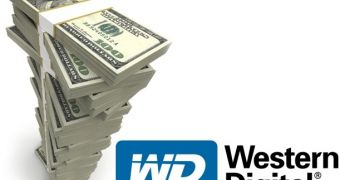After spending 4.3 billion dollars for Hitachi's HDD division last March, and right after paying 700 million worth of dividends this spring and buying Toshiba's Thailand HDD plant, Western Digital's Board of Directors approved a stock repurchase of 1.9 billion dollars.
It's quite strange to see such high amounts of money, especially cash, being spent only months after the catastrophic Thai floods that affected both Seagate and Western Digital.
In the Hitachi deal, $3.4 billion was paid in cash, while the rest was WD stock. The $700 million paid in dividends this spring was also cash, as you can't pay dividends with stock.
Now, the company, knowing it has an iron grip on the world's HDD market, wants to buy its own shares back to enjoy the huge profits that will follow.
Western Digital's move is coming just weeks after Seagate did the same thing and approved a stock repurchase of over 2.5 billion dollars.
When buying Hitachi’s HDD division, WD was conditioned by authorities to give Toshiba “certain assets” and probably some IP (intellectual property).
This was done in order to make Toshiba look like a 3.5” HDD manufacturer.
The Japanese company is traditionally a 2.5” laptop HDD manufacturer, and it only commanded less than 9% of the global HDD market with Fujitsu’s HDD division combined.
Once the asset transfer was finalized, Toshiba made a show, stating that it plans to double its market share, and then proceeded to sell its own HDD factory in Thailand to Western Digital.
We think it’s obvious for our readers that the first move when trying to double your market share is not selling your product factories.
Back in the ’90s and during the past decade, the HDD industry was plagued with overproduction and overstocking.
Manufacturers were forced to produce more than the market demanded, because this was the only way they would be able to get lower prices from component suppliers.
When a 1TB HDD was 50 USD (just 39 EUR), a HDD manufacturer had to ensure very low component prices to keep the costs low enough so that its HDDs wouldn't be too expensive.
For all the last decade, an expensive HDD meant a market share loss, as most of the HDDs were performing the same and the buyers would go for the best capacity per dollar ratio.
Manufacturers did just about everything to attract customers, even offering 3 years to half a decade of product warranty.
Nowadays, we can only dream about 3-year warranties and last year’s HDD prices.
Now that they are controlling over 90% of the global HDD market, it that seems Seagate and WD decided to play the big card.
Despite having huge product stocks (that even allowed Seagate to ship more drives than in the previous year, even with the afflicted factories) they’ve decided to ask enormous prices for their products, sometimes 300% higher than those from before the crisis.
The market panicked and started buying more HDDs to ensure last minute “discounts” and, for a while, an “out of stock” syndrome plagued the online shops.
That was not directly caused by the production interruption, but by the fact that the big OEMs were buying HDD like crazy, to ensure supply for their own system shipments.
Editor’s note:
I had to buy my HDD through the company I was working for, as most online shops were listing it “out of stock,” whereas we would be buying around 100 pieces a day for our server products. We never got the “out of stock” reply from our distributors.
The distributors were channeling most of the HDDs to OEMs that were buying large quantities, much larger than usual, fearing inability to ship systems and servers because of unavailable HDDs.
It is interesting to see if HDD prices will ever get back to spring 2011 levels.

 14 DAY TRIAL //
14 DAY TRIAL //